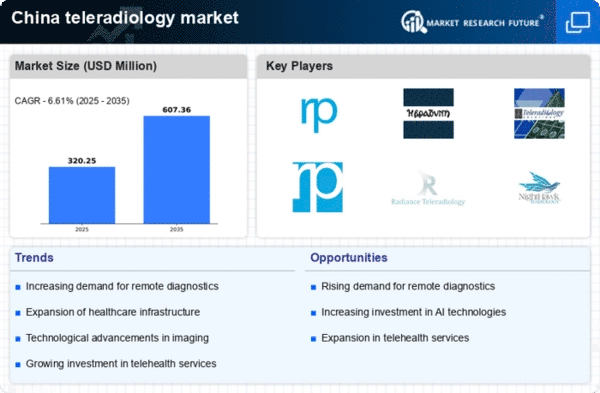Government Initiatives and Funding
Government initiatives aimed at enhancing healthcare infrastructure are playing a crucial role in the teleradiology market in China. Increased funding for telehealth services and digital health technologies is facilitating the adoption of teleradiology solutions across various healthcare settings. The Chinese government has recognized the importance of telemedicine in improving healthcare delivery, leading to policies that support the integration of teleradiology into the national healthcare framework. This support is expected to bolster market growth, with investments projected to reach $1 billion by 2027. Such initiatives are likely to create a favorable environment for the expansion of teleradiology services.
Increasing Healthcare Accessibility
The teleradiology market in China is experiencing growth due to the increasing demand for accessible healthcare services. With a vast population and a significant rural demographic, the need for remote diagnostic services is paramount. Teleradiology enables healthcare providers to deliver timely radiological services to patients in remote areas, thereby improving patient outcomes. The market is projected to expand as more healthcare facilities adopt teleradiology solutions, with estimates suggesting a growth rate of approximately 15% annually. This trend indicates a shift towards more inclusive healthcare delivery models, which is essential for addressing the disparities in healthcare access across different regions of China.
Rising Incidence of Chronic Diseases
The teleradiology market in China is significantly influenced by the rising incidence of chronic diseases, such as cardiovascular conditions and cancer. As these diseases require regular monitoring and imaging, the demand for teleradiology services is expected to surge. Reports indicate that chronic diseases account for over 80% of healthcare expenditures in China, necessitating efficient diagnostic solutions. Teleradiology provides a viable option for continuous monitoring and timely intervention, thereby supporting the healthcare system in managing these conditions effectively. This trend is likely to drive market growth as healthcare providers seek innovative solutions to meet the increasing demand.
Integration of Artificial Intelligence
The integration of artificial intelligence (AI) technologies into the teleradiology market is transforming diagnostic processes in China. AI algorithms enhance image analysis, leading to quicker and more accurate interpretations of radiological data. This technological advancement not only improves diagnostic accuracy but also increases the efficiency of radiologists, allowing them to handle larger volumes of cases. As AI continues to evolve, its application in teleradiology is expected to grow, potentially increasing market revenues by up to 20% over the next few years. The synergy between AI and teleradiology is likely to redefine standards of care in the industry.
Growing Awareness of Preventive Healthcare
There is a notable shift towards preventive healthcare in China, which is positively impacting the teleradiology market. As the population becomes more health-conscious, there is an increasing emphasis on early detection and diagnosis of diseases. Teleradiology facilitates this preventive approach by providing timely access to imaging services, enabling healthcare providers to identify potential health issues before they escalate. This growing awareness is likely to drive demand for teleradiology services, with market analysts predicting a growth rate of around 12% in the coming years. The focus on preventive healthcare aligns with broader public health goals, further supporting the expansion of the teleradiology market.

















Leave a Comment